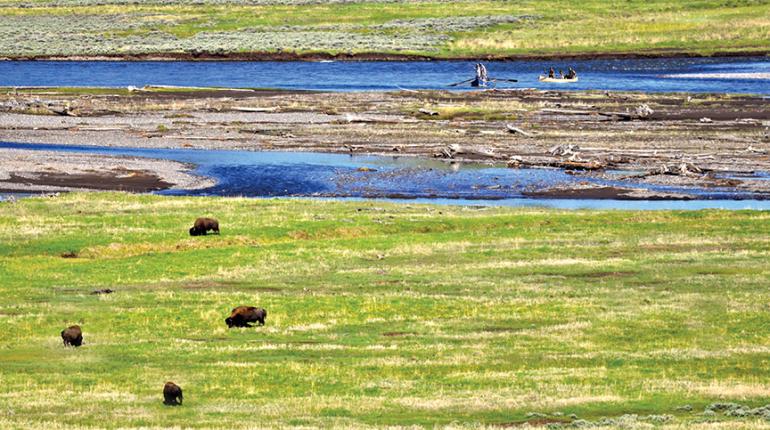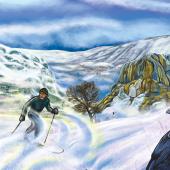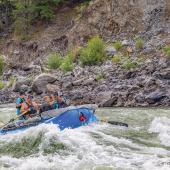To Be Oar Not to Be
Paddling access in National Parks.
Yellowstone National Park is known as a recreational paradise for hikers, campers, wildlife observers, fishermen, skiers, and adventurers. But recently another group of recreationists has been lobbying hard for more access: paddlers. The issue has raised eyebrows from Bozeman to Washington, and as in most matters concerning public resources, it's far more complex than simply whether paddlers have a place in the nation’s parks.
Boating on Park rivers and streams was banned in the 1950s, primarily to address overfishing of Yellowstone’s waters (unnecessary today due to modern management practices). But that might change if SB 2018—publicly known as the River Paddling Protection Act—passes. The bill was introduced by Wyoming Representative Cynthia Lummis in November 2013, and proposes opening Yellowstone and Grand Teton National Park waterways to non-motorized vessels for the first time in three generations.
Not all paddling is currently banned in Yellowstone and Grand Teton—recreational boaters can canoe and kayak on most Park lakes, and more than 1,000 boaters enjoy Lewis River Channel between Shoshone and Lewis lakes in Yellowstone every year. But many more streams and rivers are off-limits, ostensibly to protect delicate ecosystems and reduce human impact.
The Department of the Interior initially opposed the bill, because it would alter National Park Service (NPS) authority by “preventing them from promulgating new regulations to prevent potential future impacts associated with boating in Yellowstone and Grand Teton National Parks.” That’s a mouthful of legalese, but in short, the NPS is worried that the bill would set a precedent: Congress would have power over recreational activities in national parks.
Updated legislation language assuaged many of these worries by requiring the NPS to examine possible effects of paddling—without limiting its management discretion. It passed unanimously in the House Natural Resources Committee, and was sent to the House of Representatives in January, where it passed on February 6.
If the legislation passes the Senate, the NPS will have three years to develop an updated set of regulations governing the extended use of the 6,700 miles of waters in Yellowstone and Grand Teton. Considerations include specific water conditions, accessibility, and regulation of which rivers and streams would be open to hand-propelled boating. It’s an ambitious timeline given the immensity of the parks’ water resources.
As it stands now, supporters believe that responsibly opening these waters will allow visitors to connect with a new side of Yellowstone and the Tetons, one that is often overlooked in favor of jagged mountains, rutting bison, and explosive hot springs. Opposition concerns include increased ecological impact in some of the most remote, pristine and untrammeled portions of both parks, cost to the public, aesthetic impacts for other park visitors, and ultimately, a shift in the management culture of our national-park system.
Orville Bach and Forrest McCarthy are both outspoken advocates for national parks and wilderness, but they disagree on the need and effects of SB 2018. Read their stances and wade into the issue for yourself.
Paddle Naught
by Orville Bach
SB 2018, which includes the River Paddling Protection Act proposes to open streams in Yellowstone and Grand Teton national parks. This bill is ill-advised for several reasons.
It’s an expensive, unfunded mandate. Already at $4 million, the bill’s price tag doesn’t include earmarks for the costly and risky rescue efforts that are sure to occur in remote places like the dangerous Black Canyon section of the Yellowstone River.
It’s disruptive. Many streams meander through large meadows replete with grazing bison and elk. Paddlers wouldn’t only disrupt wildlife, but the visual pollution caused by a parade of rafts/canoes would spoil the magnificent scenery. As of now, trails steer mostly away from the rivers' edge, and visitors can enjoy the wild beauty of streams such as the Upper Yellowstone without disrupting wildlife.
It’s unnecessary. There are already plenty of wilderness paddling opportunities within Yellowstone and Grand Teton, and numerous whitewater streams are available just outside the parks. The North Fork of the Shoshone, the Gallatin, the Yellowstone, and the Jackson-area Snake River are all nearby waterways that are road-accessible in case of accidents.
It’s political. Given the fact that the National Park Service employs professional resource managers, and the public at large supports the present management of Park streams, why does Congress feel the need to intervene? Given all of the serious issues and
threats facing the park’s aquatic ecosystems, such as invasive species, drought, critical wildlife habitat, etc. it is ludicrous to force the parks to decide within three years which of the 6,700 miles of streams to open up. If selections are not made within the three-year timeline, the entirety of both parks would open up for unregulated use. This is clearly a political move and is not based on wise management and stewardship of our treasured park resources. What user group would politicians cater to next? An ATV trail across the Mirror Plateau? A golf course in Hayden Valley?
In sum, SB 2018 would have negative impacts on both Yellowstone and Grand Teton national parks, and it isn’t even sought after by the public at large. The bill would prove costly in multiple regards, and it simply isn’t necessary.—Orville Bach
Orville E. Bach, Jr. has been traveling Yellowstone’s backcountry for 45 years and has written several books on the Park, including Tracking the Spirit of Yellowstone.
Row Your Boats
by Forrest McCarthy
River paddling is one of the oldest forms of wilderness travel. Lewis and Clark first explored the mountainous West by river channel, and like freedom and democracy, running wild rivers is part of our heritage. It was Bob Marshall who said that; “Each mile on a river will take you further from home than a hundred miles on a road.”
While river-running equipment and skills have improved, access is still restricted. Wilderness paddling is an eloquent, low-impact, delightful means of travel through a wild landscape—exactly the type of experience our national parks and Wilderness areas are intended to provide and protect.
Adjacent to Yellowstone and Grand Teton national parks are the Absaroka-Beartooth and Teton Wilderness areas, where paddling is allowed—even encouraged. Glacier National Park and the Bob Marshall Wilderness Complex both permit paddling. All of these areas have similar ecosystems to Yellowstone and Grand Teton, and the megafauna peacefully coexists with wilderness paddlers.
In 2009, the Craig Thomas Snake Headwaters Legacy Act designated approximately 400 miles of the Snake River as Wild and Scenic, requiring Grand Teton and Yellowstone to develop a Wild and Scenic River Management Plan. Subject to the National Environmental Protection Act, the National Park Service was legally required and fully funded to consider all reasonable alternatives. Many of us were excited that the National Park Service was required to revisit an antiquated 1950s boating ban, and thrilled that river paddling would finally be given due process and scientific review. Yet the National Park Service refused to do either.
Today, those who support the River Paddling Protection Act share a passion for paddling and protecting wild rivers. This bill would also give the National Park Service three years to decide when, where, and how river paddling can occur in Yellowstone and Grand Teton national parks. It would not be a free-for-all, and this is a fair amount of time.
Most advocates and critics of the River Paddling Protection Act are in full agreement on 92% of the 6,700 miles of water in question. There are places that should not be paddled, including the iconic Hayden and Lamar valleys. But there are some waters that are completely appropriate, and paddling would add to the enjoyment and preservation of these parks. Is 92% agreement good enough? I hope so.—Forest McCarthy
Forrest McCarthy is a mountain guide, river guide, and advocate for non-motorized recreation. He lives in Jackson, WY.













